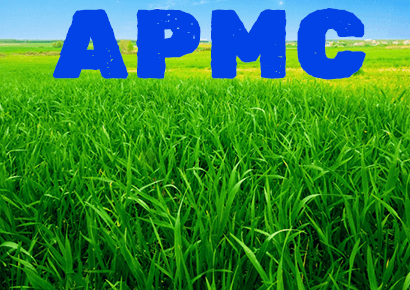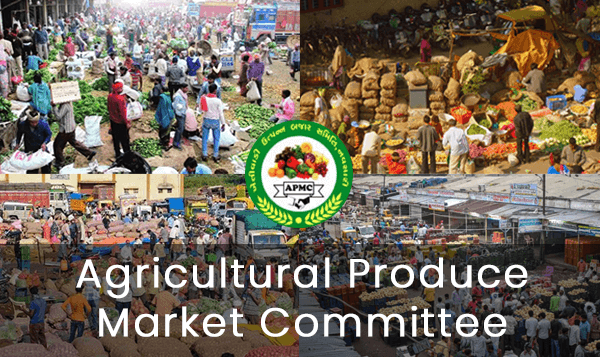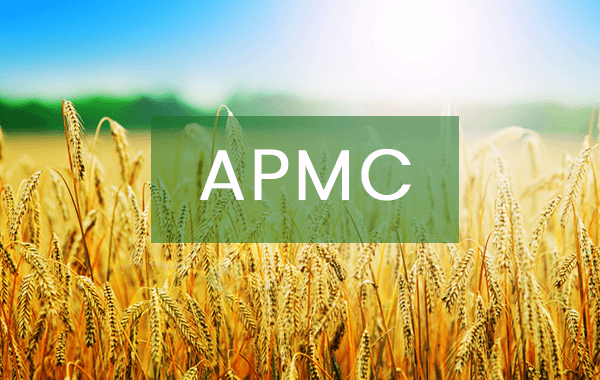What is the full form of APMCAPMC: Agricultural Produce Market CommitteeAPMC stands for Agricultural Produce Market Committee. A marketing body called the Agricultural Produce Market Committee (APMC) was set up by state governments in India to protect farmers from being taken advantage of by big retailers and to ensure that the farm-to-retail price spread does not rise to unreasonably high levels. States have the authority to regulate APMCs by passing the Agriculture Produce Marketing Regulation (APMR) Act. 
Before India's 1947 declaration of independence, government policy for agricultural marketing was primarily focused on controlling the cost of food for consumers and agricultural raw materials for the industry. However, after independence, it became necessary to safeguard farmers' interests and gave them incentive pricing to increase the production of agricultural goods. Problems with small-town money lenders extorting farmers for large volumes of foodgrains at bargain rates as interest were widespread across the nation. HistoryThe idea of regulating the market for agricultural products in India dates back to the British when the Government first became interested in raw cotton because the British emperors were eager to provide Manchester's textile mills with supplies of pure cotton at competitive costs. According to the Berar Cotton and Grain Market Act of 1887, British citizens had the right to proclaim any place within the designated district a market for buying and selling agricultural goods and set up a committee to monitor the regulated markets. As a result, the Hyderabad Residency Order established India's first regulated market (Karanja) in 1886. Other states in the nation adopted this Act as their model. The 1928 Royal Commission on Agriculture's recommendation for controlling marketing methods and creating regulated marketplaces has been a significant turning point in the nation's agricultural marketing landscape. 
Regulating business activities and establishing market yards in rural areas were two steps to address the problem. In 1938, the Indian Government created a Model Bill and sent it to all states. However, they made little progress until India gained its independence. In the 1960s and 1970s, most states established and implemented Agricultural Produce Markets Regulation (APMR) Acts. These placed all major wholesale assembling marketplaces within its purview. So, through controlled marketplaces and organization, they created agricultural marketing. A well-designed market yard and sub-yard were built, and an Agricultural Produce Market Committee (APMC) was established for each market area to establish and uphold the rules. With the aid of state governments and NITI Ayog, a United National Agriculture Market was suggested in the 2015 Union Budget. In 2020, the Indian Government passed three legislation acts that contained reforms.
Even though cartelization has been a significant issue in APMCs, farmers have expressed concern about these measures because they believe they will cause APMCs to deteriorate and eventually cause the Minimum Support Price to be reduced. Farmers in India have protested, particularly in Punjab, Haryana, and the western portions of Uttar Pradesh. OverviewAPMCs run on two guiding principles:
To divide the State geographically, each State that runs APMC markets (mandis) places its markets in various locations within its borders. Farmers must conduct an auction sale of their produce at the local mandi. To conduct business inside a mandi, traders need a license. Farmers cannot sell their goods directly to wholesale and retail dealers (such as owners of shopping centers) and food processing businesses. 2003 APMC Model ActThe following are some of the key components of the APMC Model Act 2003:
Not all states, though, have approved the legislation. Some states have passed laws without creating regulations or informing anyone. Interstate obstacles, therefore, persist by the APMC state. 
Respective State Government Duties On APMCMadhya PradeshThe Madhya Pradesh government has launched several efforts to help farmers get paid more for their goods. KarnatakaTo help farmers sell their goods at fair prices, the Karnataka government established APMCs in numerous towns. Most APMCs have markets where traders and marketing representatives can buy agricultural products from farmers. By the APMC's guidelines, farmers can sell their produce to brokers or buyers. Before 2020, farmers could only sell their products through the APMC system. Farmers became more susceptible to price manipulation by merchants and marketing agents thanks to the APMC system. The Indian Government may improve the APMC Act to the advantage of all parties. After the Karnataka government enacted the Karnataka Agricultural Produce Marketing (Regulation and Development) (Amendment) Bill, 2020, farmers were free to trade their products anywhere they pleased without needing APMCs. Additionally, it made it possible for food processing businesses to purchase directly from farmers. MaharashtraFollowing the APMC Act passed by the Indian Government, the 295 APMCs in Maharashtra are managed by the Maharashtra State Agricultural Marketing Board (MSAMB). The Maharashtra Government exempted fruits and vegetables from the APMCs in July 2016, advising farmers to send their goods directly to Mumbai for sale. The Government has granted 148 licenses for direct marketing, 91 of which are for production. In the meantime, the APMC in Pune appealed to state farmers to go to the market and sell their products themselves. Sri LankaThe governing body for agricultural markets in Tamil Nadu is the Tamil Nadu State Agricultural Marketing Board, which has been operating since 1977. To better supervise the purchasing and selling of agricultural products, 21 market committees have been established for each notified region, and 277 regulated markets are operating under these committees. Andhra PradeshIn 1966, the Government Order establishing the Andhra Pradesh (Agricultural Produce and Livestock) Markets was passed. It was updated in 1969. The Telangana Government is renowned for its farmer-friendly policies and has introduced creative programs to assist its farmers and advance the State's agricultural industry. Telangana's Department of Agricultural Marketing has been executing the e-NAM program successfully. Thanks to the wise advice of SFAC, the Department has taken several actions to promote the plan and effectively manage the mandi-level operations by utilizing the e-NAM site! Tamil NaduTamil Nadu is a significant state in southern India and contributes significantly to national agricultural production. Rice and jowar are the two main crops cultivated in Tamil Nadu. Pulses, Ragi, Bajra, Maize Cotton, sugarcane, tea, coffee, coconut, and other crops are also widely grown in Tamil Nadu. According to the provisions of the Tamil Nadu Agricultural Produce Marketing (Regulation) Act, 1987 and its Rules 1991, 284 Regulated Markets in Tamil Nadu are operating under the supervision of 27 Market Committees. The e-NAM portal is integrated with the State's regulated markets, and the Department is steadily trying to improve the efficiency of end-to-end market operation by leveraging digital technology. APMC Schemes & OccasionsDigital Weighing ScalesTo improve the accuracy of weighing commodities, 1257 digital weighing scales and 2 weighbridges in Telangana's e-NAM mandis have been linked with the e-NAM site using Bluetooth equipped POS machines. By taking this creative action, the Department has decreased the manual entry and the accompanying inaccuracy when inputting weighing-related data on the e-NAM site for later use and creating the sales invoice for the goods. The intervention also brings about overall efficiency in trading activities carried out via e-NAM and saves time and money. Machines For Assaying Chillies Installed in Telangana's E-NAM MandisIndia is the world's largest producer of spices, and chilly is a universal spice of the nation. Telangana is one of the nation's major red chili-producing states. These include Khammam, Mahabubabad, Gadwal, Suryapet, and Warangal, the principal cold-growing districts. The worldwide market strongly demands Chilly hybrid types such as 334 and Teja. For the benefit of Telangana's chilly farmers and traders, the Government has installed CT Vieu Chilly machines (C-DAC) for Red Chilly Assaying in the five e-NAM mandis, namely Khammam, Warangal, Kesamudram, Hyderabad, and Mahabubabad. This will ensure that the chillies traded in these mandis meet high-quality standards. 
A non-intrusive, user-friendly method prepared to connect to e-Auction (eNAM), which combines mechanical, electronic, and digital image analysis technologies, allows for a quick study of appearance-based quality indicators for chillies. In just five minutes and with a sample size of 1 kilogram, it can measure characteristics including colour, pod length, broken pods, pods without stalks, foreign matter, loose seed, discoloration, and damage without the need for user participation. The advanced equipment, equipped with cutting-edge technology, meets the needs and requirements of customers in both domestic and international markets while paying Telangana's chilli growers a fair price, depending on quality. Awards and Honours

In e-NAM, cotton producers receive profitable pricing. Telangana's Mandi-Khammam region. Telangana cotton growers are receiving rates on e-NAM in the Khammam market that has never been witnessed before. In one of the positions, Mr. Telu Veeraiah from the village of "Gigollapally," who won the highest price for a cotton farmer (he received Rs. 11,125 per quintal on March 24, 2022), was honored by the district's assistant collector in the presence of the chairperson of the APMC Khammam and the selection grade secretary of the APMC Khammam. That day, Mr. Telu Veeraiah sold a total of 1.96 quintals of cotton for Rs. 0.22 lakhs. He frequently trades via e-NAM because he finds the procedure rapid and transparent, encouraging competition among traders. On March 24 and 22, they realized a median price of Rs 11,000 in the mandi. They traded 59 cotton quintals for lots, with an average bid of "2" throughout the day. Another instance occurred on March 26, 2022, in the Khammam market, where cotton sold for the highest price, Rs 12,001 per quintal. A farmer was paid this sum from Aswraopuram in Telangana's Kottagudem district. The lowest price per quintal realized on this day was Rs 9,000. The cost per quintal was, on average, Rs 10,500. Tamil Nadu is one of the top e-NAM Implementing States in e-Payments. ConclusionThe Indian Government implemented several necessary restrictions to create a system to oversee market behaviour after realizing the flaws farmers had to deal with, such as losses due to excessively low prices, higher marketing costs, and significant physical losses of the food. Market development and regulation for main agricultural products were acknowledged as institutional innovation. A key requirement for regulating the practices in primary wholesale markets was constructing well-designed market yards.
Next TopicFull Form
|
 For Videos Join Our Youtube Channel: Join Now
For Videos Join Our Youtube Channel: Join Now
Feedback
- Send your Feedback to [email protected]
Help Others, Please Share










